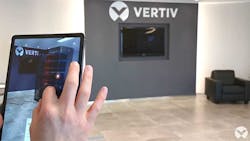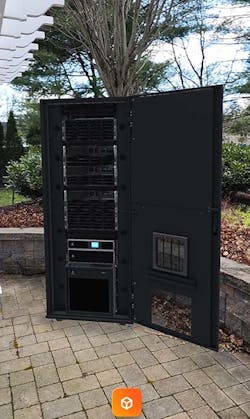Vertiv Gets Immersive With XR App Displaying Virtual Data Center Equipment
Ever wondered what it would look like if you added a new piece of equipment in your data center? Wonder no more, as a Vertiv app uses mixed reality to let you visualize what new gear will look like in data center or office.
The Vertiv XR mobile app is part of a growing movement to adapt mixed reality tools for use in data center design and management. It's available for Android or iPhone, and helps users visualize their environment with the addition of a range of Vertiv equipment, from a single-rack micro data center right up to UPS units and cooling cabinets.
The concept is similar to "Pokemon Go," inserting computer-generated images onto your phone screen that "appear" in your real-world surroundings - only with Liebert chillers instead of Pikachu or Charizard. The app provides a 3D view of the equipment as you move your phone or walk around the room - including side and rear views of the equipment.
Vertiv has been using its VR technology in demonstrations on trade show booths using VR headsets, enabling users to view equipment inside a virtual data center. With the mobile app, Vertiv adapts use cases from the home remodeling industry to envision changes to a familiar environment.
The Vertiv XR app guides users through product selection and placement, using augmented reality to create a surprisingly realistic depiction of the product in the location of your choosing – whether that’s a data center, office, lobby or even your patio.
It's a conversation starter and educational tool for data center professionals considering upgrades or expansions.
“The app allows our customers and partners to make more informed buying decisions and recommendations, to visualize in a tangible way how new products will interact with their existing environments, and explore details about those products, all from the palm of their hand.” said Cristian Scarpa, CIO EMEA & Global VP Customer & Employee Technologies at Vertiv.
Adapting Mixed Reality to Digital Infrastructure
Virtual reality (VR) allows users to interact with digital environments and objects, while augmented reality (sometimes known as mixed reality) integrates digital imagery into a user’s field of vision. VR and AR can be experienced using a headset, but also through devices like smartphones and tablets.
Virtual reality has long been touted as one of the next Big Things in technology. For all its promise, mass adoption of VR and mixed reality has seemed to always be on the horizon. Five years ago, Gartner predicted that widespread enterprise adoption of immersive mixed media technology would happen by 2021.
That vision was interrupted by the global spread of COVID-19 beginning in early 2020, which shifted the IT investment focus to video conferencing and remote operations.
In the early days of the pandemic, data center operators added virtual tours that could help customers provision data center space while maintaining tight access control in mission-critical facilities. Some companies, including NTT Global Data Centers, had already been conducting remote tours via virtual reality headsets, and Microsoft built an entire virtual data center in Unreal, reflecting the design used in its Quincy, Washington campus.
Microsoft also began using its HoloLens mixed reality technology to provide remote auditors a detailed look inside Microsoft Azure data centers, enabling compliance audits to continue during the pandemic and dramatically reducing travel for member of its cloud team.
Vertiv says its XR app is part of a sweeping digitization effort to update digital assets to "engage with customers and partners on their terms."
About the Author




